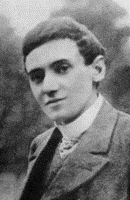Name William Hurlstone Role Composer | ||
 | ||
Died May 30, 1906, London, United Kingdom Similar People Walter Willson Cobbett, Arnold Cooke, Charles Villiers Stanford, Joseph Holbrooke, Samuel Coleridge‑Taylor | ||
William hurlstone piano trio
William (Yeates) Hurlstone (7 January 1876 – 30 May 1906) was an English composer who studied piano and composition at the Royal College of Music, after gaining a scholarship. His piano professors were Algernon Ashton and Edward Dannreuther. His composition teacher, Sir Charles Villiers Stanford, considered Hurlstone, among the many brilliant students whom he taught, to have been the most talented. In 1906, Hurlstone returned to the college as Professor of Counterpoint, but died later that year of bronchial asthma. He is buried in Croydon Cemetery with members of his family, though the monumental cross that surmounted the grave has been destroyed. The monumental cross that is in situ over William's grave was designed as a broken cross to signify that William had died before reaching his peak.(T. Hurlstone)
Contents
- William hurlstone piano trio
- Clarinet piano four characteristic pieces william hurlstone
- Musical works
- Editions of his music
- Recordings
- References
Clarinet piano four characteristic pieces william hurlstone
Musical works
The greater part of Hurlstone's body of work consists of works for chamber ensembles. Although they are of consistently high quality, none achieved any great fame. Among the better known are
Additionally, he composed four instrumental sonatas for:
There is also a Quintet in G minor for flute, clarinet, horn, bassoon and piano.
His orchestral works include
Hurlstone was considered by Stanford to have been prone to being of the great composers of the early 20th century. Stanford considered him the most talented of his pupils, above Ralph Vaughan Williams and Gustav Holst.
